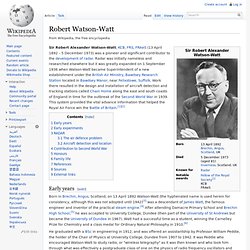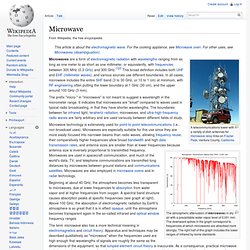

Robert Watson-Watt. Sir Robert Alexander Watson-Watt, KCB, FRS, FRAeS (13 April 1892 – 5 December 1973) was a pioneer and significant contributor to the development of radar.

Radar was initially nameless and researched elsewhere but it was greatly expanded on 1 September 1936 when Watson-Watt became Superintendent of a new establishment under the British Air Ministry, Bawdsey Research Station located in Bawdsey Manor, near Felixstowe, Suffolk. Work there resulted in the design and installation of aircraft detection and tracking stations called Chain Home along the east and south coasts of England in time for the outbreak of the Second World War in 1939. This system provided the vital advance information that helped the Royal Air Force win the Battle of Britain.[1][2] Early years[edit] He graduated with a BSc in engineering in 1912, and was offered an assistantship by Professor William Peddie, the holder of the Chair of Physics at University College, Dundee from 1907 to 1942.
Early experiments[edit] Robert Watson-Watt. Robert Watson-Watt is credited with inventing the radar which played an invaluable part in the Battle of Britain.

Robert Watson-Watt can be considered one of the unsung heroes of World War Two - very many know about his invention, yet few know his name. Robert Watson-Watt was born April 1892 in Brechin, Scotland. Sir Robert Watson-Watt. Radar Personalities Sir Robert Watson-Watt Sir Robert Watson-Watt was born in Brechin, Angus and was educated at Damacre School in Brechin and Brechin High School.

He graduated with a BSc(engineering) in 1912 from University College, Dundee which was then part of the University of St Andrews. Following graduation he was offered an assistantship by Professor William Peddie who excited his interest in radio waves. In 1915 Watson-Watt started as a meteorologist at the Royal Aircraft Factory at Farnborough with the aim of applying his knowledge of radio to locate thunderstorms so as to provide warnings to airmen. In 1924 Watson-Watts work moved to Slough where the Radio Research Station had been formed and in 1927, following an amalgamation with the National Physics Laboratory (NPL), he became Superintendent of an outstation of the NPL at Slough.
Following an approach from H.E. Robert Watson-Watt biography. Famous for: Discovering radar as a crucial means of defence during the Second World War Using radar for air and maritime navigation during peacetime.

Robert Watson-Watt was a pioneer of radar technology. Although he did not invent the idea of radio detection, he was the first to prove it could work on a large scale. Welcome to the Robert Watson-Watt Society of Brechin. Microwave. The atmospheric attenuation of microwaves in dry air with a precipitable water vapor level of 0.001 mm.

The downward spikes in the graph correspond to frequencies at which microwaves are absorbed more strongly. The right half of this graph includes the lower ranges of infrared by some standards Microwaves are a form of electromagnetic radiation with wavelengths ranging from as long as one meter to as short as one millimeter, or equivalently, with frequencies between 300 MHz (0.3 GHz) and 300 GHz.[1][2] This broad definition includes both UHF and EHF (millimeter waves), and various sources use different boundaries.
In all cases, microwave includes the entire SHF band (3 to 30 GHz, or 10 to 1 cm) at minimum, with RF engineering often putting the lower boundary at 1 GHz (30 cm), and the upper around 100 GHz (3 mm). The prefix "micro-" in "microwave" is not meant to suggest a wavelength in the micrometer range. Microwave sources[edit] Uses[edit] Communication[edit] Radar Basics - Magnetron. Cavity magnetron. Magnetron with section removed to exhibit the cavities.

The cathode in the center is not visible. The waveguide emitting microwaves is at the left. The magnet producing a field parallel to the long axis of the device is not shown. A similar magnetron with a different section removed. Central cathode is visible; antenna conducting microwaves at the top; magnet is not shown. Construction and operation[edit] A cross-sectional diagram of a resonant cavity magnetron. The sizes of the cavities determine the resonant frequency, and thereby the frequency of emitted microwaves.
The magnetron is a self-oscillating device requiring no external elements other than a power supply. Where there are an even number of cavities, two concentric rings can connect alternate cavity walls to prevent inefficient modes of oscillation. The magnetron is a fairly efficient device. Applications[edit] Magnetron from a microwave oven with magnet in its mounting box.